November programme for the VivoArts School for Transgenic Aesthetics
Posted in: Uncategorized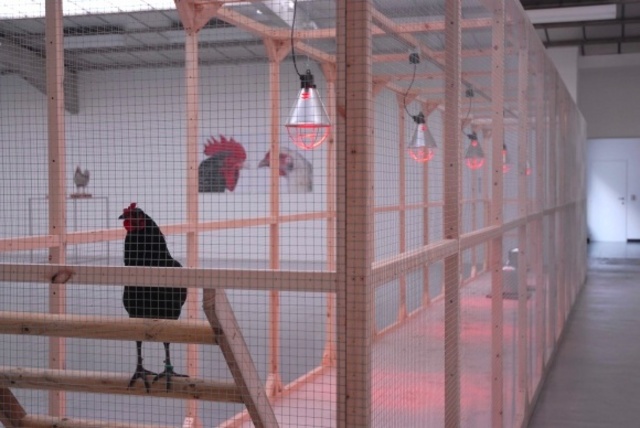

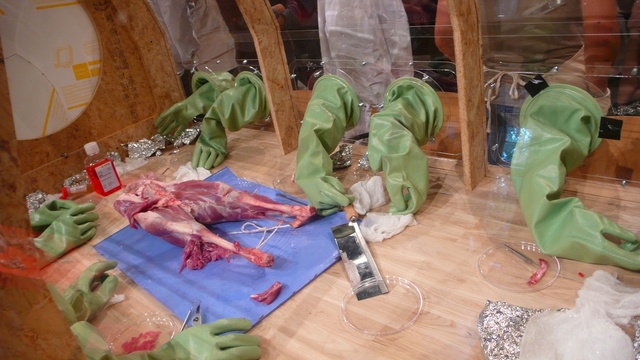
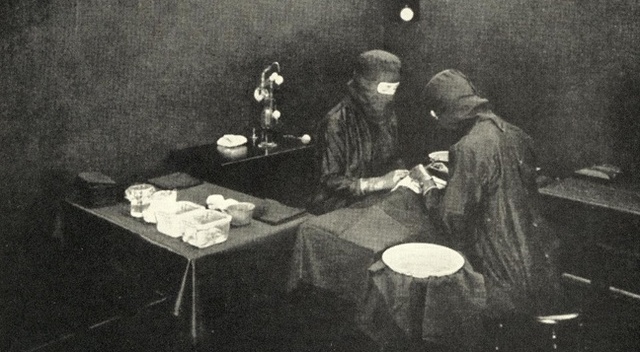
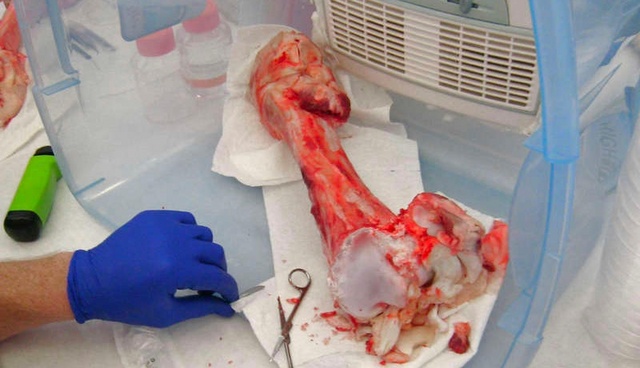
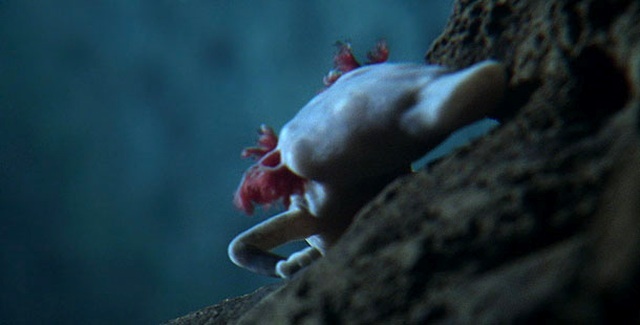
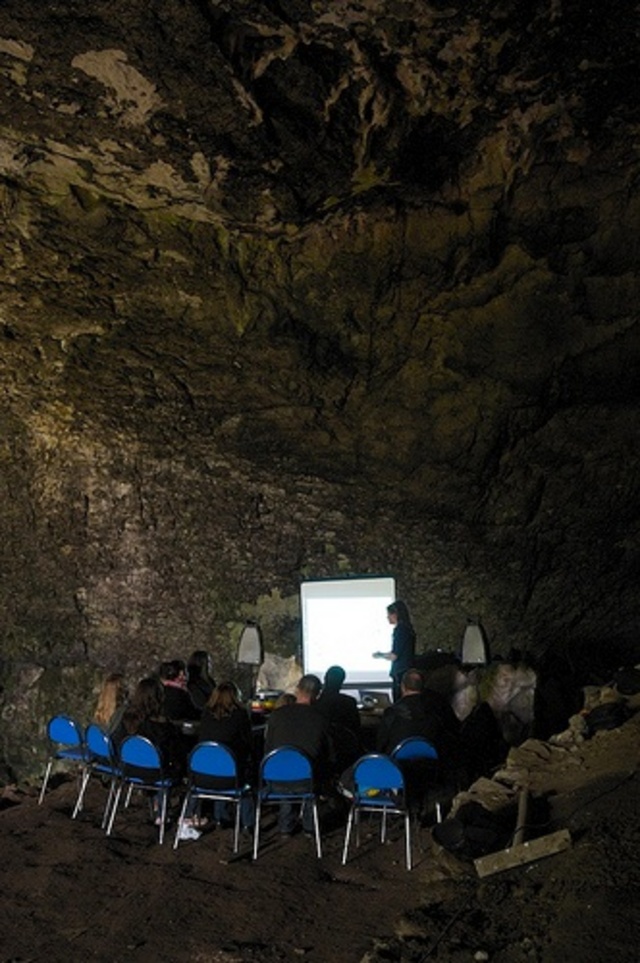
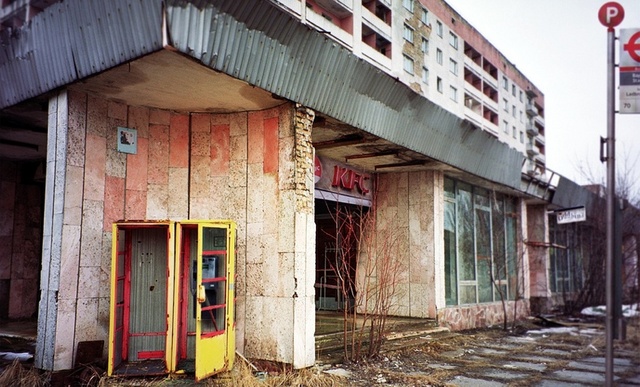
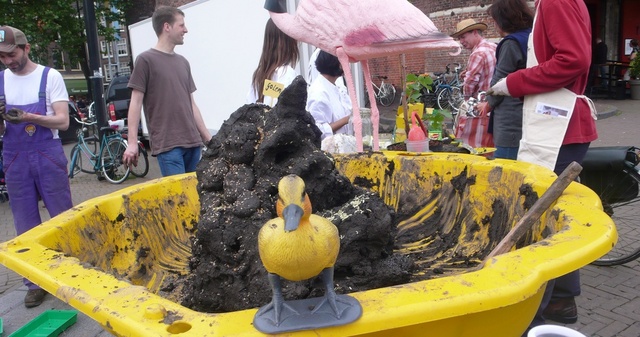
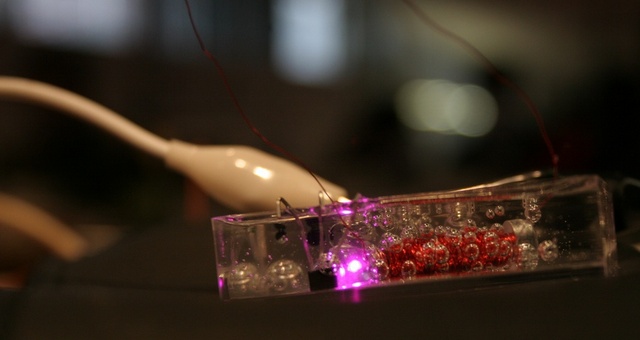
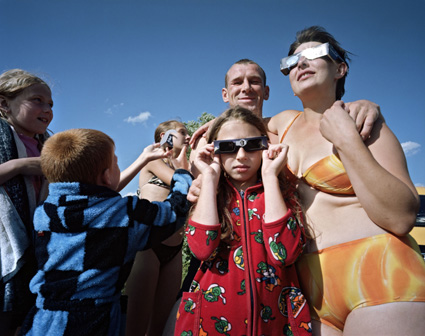
Group of Russians admiring the eclipse in the beach of Pervomaiskoje, Altai Krai, the locality where Tommi Taipale arrived on the eclipse day on his Journey to the Eclipse. Photo credit: Tommi Taipale
Last Summer, curatorial research group Capsula embarked on the first of its Curated Expeditions, demonstrating in the process that you don’t need an intergalactic spaceship to uncover new territories and make meaningful discoveries. This series of Curated Expeditions are research trips that engage with earthly phenomena through artistic investigation.
The 1st Expedition of Capsula invited 3 artists to observe a total solar eclipse which took place on August 1st over a vast area stretching from Canada, through to Russia, Mongolia and China. The observation location selected is the scientific Zoo in Novosibirsk, the capital of Siberia. Eclipse started in Novosibirsk at 17.45 pm.
The artists, German Agnes Meyer-Brandis, Catalan Mireia C. Saladrigues collaborated with the Zoo personnel and other experts to study the celestial phenomena and its impact on the animals and the visitors of the Zoo while Finnish photographer Tommi Taipale focused his work on the cultural and geographical distance between of Finland and Siberia.
Because Capsula’s latest focus is the relation between art and biology and environmental culture, the expeditions go hand in hand with a more leisurely and sometimes old-fashioned Philosophy of Voyage: walking, bob-sleighing, swimming, hitchhiking, rowing, sailing, trains and submarines. The travel from Finland to Novosibirsk took several days: While Tommi chose to hitch-hike, curator Ulla Taipale, Agnes Meyer-Brandis and Mireia C. Saladrigues spent three days to get there by train, taking the romantic-sounding Trans-Siberian Line.
With a background in Environmental Engineering and and Communications, Ulla Taipale is one of the founders and the current head of Capsula. I asked her to give us more details about this first curated expedition to Siberia:
Can you present us Capsula briefly? When and how it was born? What are its objectives?
 Capsula was founded by Mónica Bello Bugallo and Ulla Taipale in 2005 in Barcelona. It is a platform that creates cultural content and curatorial projects dealing with art, science and nature. The first project of Capsula was Days of Bioart in 2006. The event was a combination of a bioart seminar and SymbioticA Tissue Engineering and Art – workshop and organized in Centro de Arte Santa Mónica and in a laboratory of faculty of biology of Universidad de Barcelona. The cross-disciplinary approach has been characteristic of Capsula`s work from the beginning. In recent years Capsula has collaborated with cultural institutions such as CCCB (Centre for Contemporary Culture of Barcelona) and Intermediae in El Matadero of Madrid, DRU-Digital Reserch Unit of Huddersfield, among others, and have brought to these events many of the leading creators and researchers in the field of art, science and/or technology, such as Critical Art Ensemble, Tissue Culture & Art Project, Andy Gracie, Natalie Jeremijenko, Vandana Shiva, Jens Hauser, Ramon Guardans and Eugene Thacker, to name a few. The objective is to create interdisciplinary projects related with art&science, with a special attention on the natural and artificial environments.
Capsula was founded by Mónica Bello Bugallo and Ulla Taipale in 2005 in Barcelona. It is a platform that creates cultural content and curatorial projects dealing with art, science and nature. The first project of Capsula was Days of Bioart in 2006. The event was a combination of a bioart seminar and SymbioticA Tissue Engineering and Art – workshop and organized in Centro de Arte Santa Mónica and in a laboratory of faculty of biology of Universidad de Barcelona. The cross-disciplinary approach has been characteristic of Capsula`s work from the beginning. In recent years Capsula has collaborated with cultural institutions such as CCCB (Centre for Contemporary Culture of Barcelona) and Intermediae in El Matadero of Madrid, DRU-Digital Reserch Unit of Huddersfield, among others, and have brought to these events many of the leading creators and researchers in the field of art, science and/or technology, such as Critical Art Ensemble, Tissue Culture & Art Project, Andy Gracie, Natalie Jeremijenko, Vandana Shiva, Jens Hauser, Ramon Guardans and Eugene Thacker, to name a few. The objective is to create interdisciplinary projects related with art&science, with a special attention on the natural and artificial environments.
The last project of Capsula, called Curated Expeditions, was launched almost one year ago. The project is dedicated to observing and experiencing fascinating natural phenomena through the work of artists, scientists and other cultural agents. It also wants to revive leisurely traveling experiences, which have almost been cast aside by the frantic pace of modern day life. The first expedition was carried out last summer in Russia to explore and study the total solar eclipse and animal behaviour during this celestial phenomenon. This was realized through the proposals of German media artist Agnes Meyer-Brandis and Catalonian visual artist Mireia C. Saladrigues. On the other hand the expedition of Finnish photographer Tommi Taipale focused on the cultural and geographical distance between of Finland and Siberia during his journey to the eclipse by hitch-hiking. The project was done in collaboration with Novosibirsk Zoo in Siberia and with several other institutions, mentioned in the end of the interview.
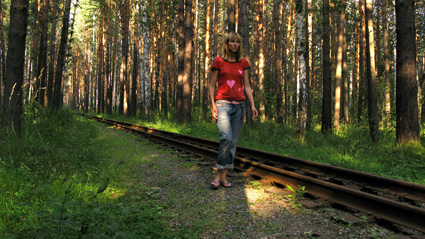
Ulla Taipale wandering in the vast forest by the Novosibirsk Zoo. Photo credit: Ulla Taipale
Curated Expeditions is a long-term project. Can you explain what are its long-term goals?
The object is to make a series of expeditions dealing with earthly phenomena in remote and nearby destinations . The aim is to stimulate production and exhibition of multidisciplinary artistic creation related with nature’s spectacles. I have many ideas for new expeditions and for the targets of the artistic survey, but these plans are in an early stage and not ready to be published yet.
Through these projects I want to give the protagonism to the natural phenomenon and promote positive emotions that can be experienced in natural and artificial environments. The question is: Could the natural phenomenon and the spectacles of the nature still fascinate a major quantity of people in the modern world, saturated by entertainment like video games and action movies? And, could these splendid and thrilling emotions lived within the nature, shift the attitude of people to more respectful and caring direction concerning their environment? Generally speaking, conservationism and environmentalism seem to be related with obligations and rejections that limit the level of life causing bad conscience. Sustainable way of life is related with low quality life – without luxury. I expect that the outcome of the expeditions – singular artworks, exhibitions, public debates and writings address towards to the enriching experiences reducing a distant and unconcerned attitude when thinking about nature and our relationship with it.
So, to name some of the more tangible goals – maybe in five years and after several expeditions a publication will be made out of these projects. And the new artworks created are to be exhibited in traditional and non-conventional spaces. I would also like to gather interesting people, not necessarily experts, but persons with good ideas to discuss publicly the issues indicated by the expeditions. The idea is to break categorizations and frontiers between different disciplines.
Curated Expeditions explored a phenomenon which lasted 2 minutes and 20 seconds. Yet you deliberately traveled using relatively slow and old-fashioned ways. You, Agnes, and Mireia took an almost 3 day train ride from Helsinki to Novosibirsk, while it took Tommi a whole week to get there by hitch-hiking. Why was it so important to undertake a long journey when (apparently) you didn’t have to?
Curated Expeditions wants to revive leisurely traveling experiences that personify the Capsula Philosophy of Voyage. Walking, bob-sleighing, swimming, hitchhiking, rowing, sailing, trains and submarines, just to name a few, are means of transport that permit your soul to arrive to the destiny simultaneously with your body. No matter if the destiny for the artistic exploration of the natural phenomenon is near or far, the participants should be aware of the distance and the differences- cultural and geographical ones – between of the departure and arrival.
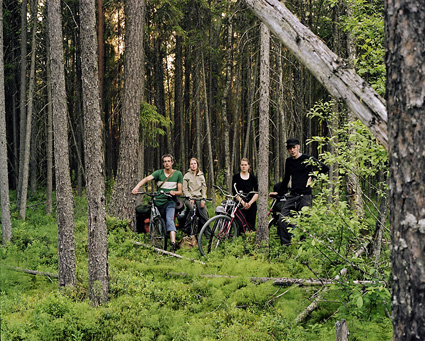
Tommi Taipale, Siiri Anttila, Selja Eskonen and Heikki Tuorila cycling in Russia. Photo credit: Tommi Taipale
We didn´t have to spend three days on the way and also it would have been less expensive and troublesome to take a direct flight to Novosibirsk. Many people warned us telling about uncomfortable and dangerous trains, we were asked several times why not to travel flying, that Russian people were noisy, in the summer the wagons would be hot and in general very inconvenient for three women with a lot of luggage. I have to admit, that I was questioning the decision many times. Also buying the tickets for exact days and routes was not easy at all because of Russian bureaucracy, holiday season and the mass movement of eclipse tourists. But, at the end we were in Helsinki railway-station with our huge luggage – Agnes was carrying 60 kilos on her – and the journey could start.
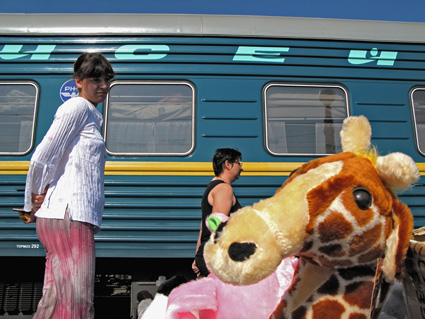
A break in a station on the Russian Trans-Siberian railway. Photo credit: Ulla Taipale
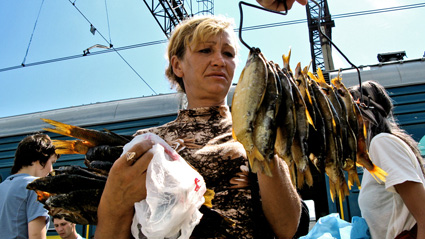
Russian train passanger selects fish, offered by “babuskas”, local grandmothers sell in railway-stations. Photo credit: Ulla Taipale
Once in the train, we did forget our doubts! During the three days between Helsinki and Novosibirsk we were able to learn some Russian, to know Russians, to know each other on a more personal level, converse, read books, watch the changing scenery from the window and while enabled and disconnected from the internet, got slowly into the mood of Capsula Expedition. And once we arrived, we were sad to leave our temporal itinerant home, the Russian co-travelers, the samovar and the rhythmic sound of the train.
Coming to Tommi, he spent two weeks on the road to get to Novosibirsk. As an experienced Russian traveler and wanderer, he could estimate roughly how long time it would take to get from place to another. During the first days he traveled with three friends using recycled bicycles and then alone towards to the tundra by hitch-hiking and using some river-boats. This extra round to the northern part of Russia was his attempt to escape the heat – the summer in Russia was hot, during July – August the daily temperatures rose up to 30ºC almost every day. However, even in Salehard it was sweaty!
Hitchhiking in Russia is a very common way to travel. To get a hitch is not difficult and a lonely Finn on the road wakens curiosity and hospitality in Russians – often he was offered also a place to sleep on the way.
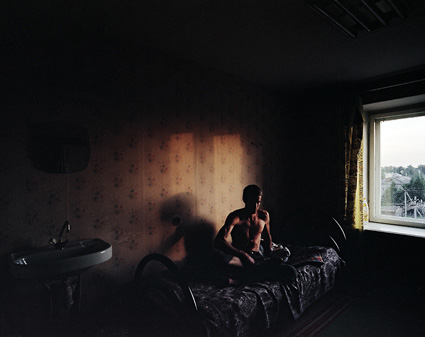
Tommi Taipale in a hotel room in Nikolsk, on his way to the total eclipse. Photo credit: Tommi Taipale
Tommi´s photographs reflect his meetings with ordinary people that can be found traveling alone leisurely in a strange territory. He has a basic Russian knowledge that allows him to connect with people who coincide with his fortuitous way that doesn’t respect timetables. His pictures open doors to the everyday life of Russians showing what often remains behind of the topics of the country, such as the life habits of the of class of new rich, the alcoholism and poverty, and the country’s military and energy power. In these glimpses shown in Tommi´s pictures a grandmother offers a lonely traveler sweet tomatoes or cranberries, a mine worker invites him to take a bath in a banja, Russian sauna or a group of silent men waiting for a river-boat in the dawn.
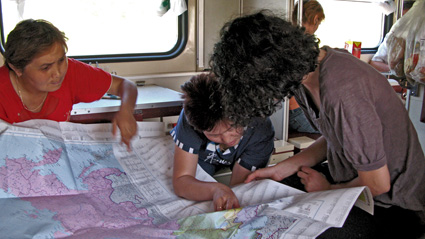
Mireia C. Saladrigues studies Russian map with Kirgisian co-travellers in the Trans-Siberian wagon. Photo credit: Ulla Taipale
By the way, is a journey on the Trans-Siberia as romantic as it sounds?
To our surprise it was big pleasure, nicer than we could ever imagine. You can do it more comfortably with a bigger budget in a higher class, having a daily shower and your own toilet, but then you might miss the contact with the co-travelers and a part of the taste of adventure. And the official Russian time, that shows Moscow hour where ever the train is in Russia, makes your daily rhythm disappear – instead of looking at your watch to start eating and sleeping, you let your state of mind or energy levels decide what to do. Our public relations and Russian language rehearsals always got more interesting and intensive the nearer we got to Novosibirsk. During the last hours in the train, Mireia found the first volunteer, a Russian girl to work with her in the project in Novosibirsk. Something very characteristic for Mireia´s work, which is based on her interpersonal skills and communication with people.
Anyway, I have to admit that we three adapt well to tough conditions. Traveling in Russian trains is good as long as you don’t except too comfortable a life and are not too prejudiced.
The zoo of Novosibirsk in Siberia seems to be a very intriguing place. How did you get to know about its existence? How did the owners and workers of the zoo welcome a bunch of artists keen on mingling with their animals?
When the decision to start the Curated Expeditions project by investigating a solar eclipse was taken, I started a closer study of the zone of totality, that was a vast area from Alaska, Siberia and Mongolia to China.
In 1999 I experienced my first solar eclipse in Hungary, in a small village of Rapabatona by the Danube, where I cycled from Vienna. I was astonished by the reaction of animals, mostly birds and insects, during the eclipse. So, when I found out that the biggest and oldest Zoological Park of Russia was situated in Novosibirsk, just in the middle of the eclipse zone, I decided to focus the project on the animal behaviour during the eclipse. The negotiations with the Zoo started and after weeks of correspondence and phone calls they agreed to collaborate.
We were made very welcomed. Sveta, the secretary of the Zoo, came to pick us up from the railway-station, and took us to our new home. We were invited to stay in an apartment situated in the Zoo area that is normally used by foreign zoologists and researchers visiting the Zoo. Novosibirsk Zoo Park is huge. The area consists of 53 hectares of pine forest and it is a home for around 12 000 animals and 634 species. Bengal tigers and snow leopards are among the 120 endangered species represented in the Zoo that can be found in the Red Book. Our neighbours and their numerous different ways of sonic communication filled the air with roaring, yelling and howling, especially in the dusk and dawn. Our communication with zoo workers was possible thanks to Sveta and Maria, Siberian English literature students, who were the links between us, the zoo workers and the journalists. English is rarely spoken in Russia, but the young people start to be stronger in languages than their parents who did their studies during the Soviet time.
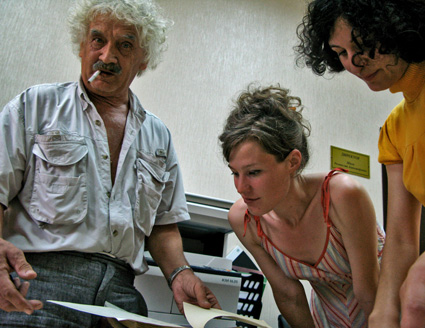
Agnes Meyer-Brandis and Mireia C. Saladrigues study notes from the year 1981´s annular eclipse animal behavior with the Zoo director Rostislaw Shilo.Photo credit: Ulla Taipale
We presented our intentions to the director Rostislaw Shilo, who runs the Zoo with 40 years of experience. Him and his wife, the scientific director Olga Shilo, are highly liked and respected personalities in Novosibirsk and people from taxi-drivers to biologists have positive things to say about them. In parallel with running the biggest Zoo in Russia and his scientific work, Rostislaw Shilo is also a Siberian eco politician, influencing environmental issues from the parliament of Siberia. Once we explained the goals of the expedition he didn’t hesitate in supporting the project. Not only did he offer us nice accommodation for nine days, but also helped us further in achieving rare moon geese for Agnes´ experiment and in gaining visibility in the Siberian media, among other things. We are very grateful for his and the all zoo personnel support, they were very generous and shared their knowledge with pleasure.
Russians are quite reserved and it is hard to know what the animal caretakers and other personnel really thought about our visit, but after breaking the ice they were more than cordial.
Some of the projects, in particular the one of Mireia C. Saladriques involved the participation of the public. How did it go? What happened?
Mireia´s project, called Zoolar Eclipse was fully realized within the installations of the zoo. Zoolar Eclipse investigated animal reactions when the darkness, caused by the total eclipse, suddenly fell into the Zoo. Not only the volunteer zoo visitors participated in her work, but she also got very connected with some of the animal caretakers despite the language barrier. During our stay in the Zoo she was following a daily program to observe and study through drawing the animals selected. The animals were selected following her own intuition and advice given by Dr. Sabater Pi, Catalonian ethologist and primatologist, and the director of the Zoo of Helsinki, Seppo Turunen. The final selection consisted of white-handed gibbon, eagle owl, liger, yellow-throated marten and polar bear. Liger, one of the main crowd-pullers of the Zoo, is a hybrid cross between of male African lion and a tigress. She also participated in animal´s feeding and daily routines with zoo personnel. Mireia woke up with the sun around five or six o´clock in the morning to realise her first walk by the animals with her pens and sketch book, then again between four and six o´clock (the eclipse hour) and the days were completed by the last round at sunset. Through these observations and interviews with the zoo personnel she wanted to learn the habitual behavior of the animals during the different positions of the sun.
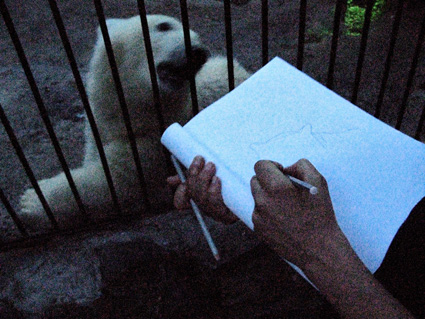
MIreia C. Saladrigues drawing a polar bear in a semi dark Zoo Park. Photo credit: Ulla Taipale
At first we were worried about not finding enough people to take part in the survey. These concerns disappeared once in Novosibirsk. On a normal summer day the Zoo counted more than 10 000 visitors. The news about this special opportunity spread also through the seven biggest TV-news of Siberia that interviewed us and the invitation to participate in the project circulated around through television, radio, city forum in internet and by Mireia´s posters in the Zoo.
On the actual eclipse day, Mireia and ten Russian volunteers delivered and recollected the Zoolar Eclipse postcards for and from one hundred zoo visitors, interested in writing their impressions of the effects of the sudden disappearance of the sun. She herself decided to observe the gibbons. In the moment of eclipse, she says, the role of the one that in the zoo normally is observed – the gibbon – changed and these primates were the ones that observed the humans, totally excited, yelling and shouting as apes in a state of climax.
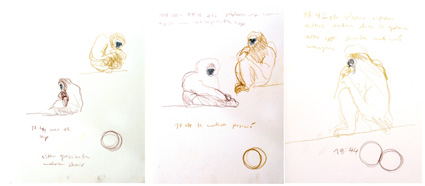
During the totalirity, Mireia C. Saladrigues chose the white-handed gibbons of Zoo as the object of her observation, due to their similarity with the humans. The drawings explain their activities during the eclipse. Image credit, Mireia C. Saladrigues
The texts by zoo visitors are now being translated from russian to finnish, english and to spanish and the contents seem to be quite touching and subjective. People have interpreted the behavior of animals in very different ways. The writings describe also strange physiological changes in the observers themselves, such as headache, dizziness, extreme feelings of happiness and even sudden hunger. The texts will be available on the website of Capsula Expeditions once they have been completed in english.
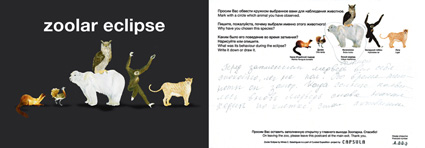
A postcard by Mireia C. Saladrigues and the written observations by a Novosibirsk Zoo visitor. Image credit, Mireia C. Saladrigues
While Mireia´s work took place in semi-artificial surroundings inhabited by wild animals, Agnes moved special Moon Geese to a natural setting to realise her bio-poetic investigation. The Moon Goose Experiment is based on a text by english bishop Francis Godwin and was published first in 1638 in the book called “The Man in the Moone”. The geese of Godwin`s novel fly to the Moon instead of heading to the South in autumn. Would that be something that could happen for some species of migrating birds soon, as an consequence of the search for more suitable habitats than a polluted planet Earth, facing the effects of climatic chaos?
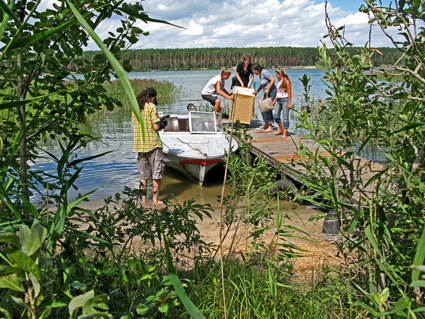
Arrival on the Sacred Scarabeus island, where the Moon Goose Experiment was carried out. Agnes Meyer-Brandis and Alexandra Deribas unload the moon flight equipment. Photo credit, Ulla Taipale
To find the required thirteen suitable Moon Geese and a runway for a moon flight in beautiful natural surroundings was an adventure, and only the determination of Agnes made this possible. Despite the fact that geese are protagonists of her work, also here the local people were playing a very important role in helping to carry out the plan. With the collaboration of Novosibirsk assistants we experienced unforgettable moments in a russian datsa, a typical small farmhouse with all kind of domestic animals, and on a sand island that was chosen to be the experiment scenery. This datsa was situated near to the Academgorodok, the Soviet époque’s ambitious science city project.
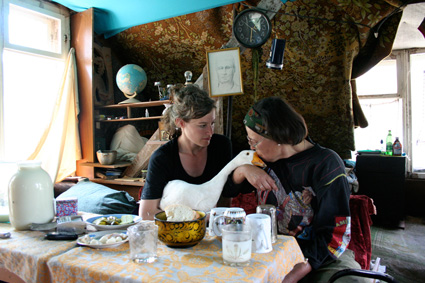
Agnes Meyer Brandis and Alexandra Deribas during geese training in Moon Goose Home, “Datsa” (little farm) of Alexandra and Gennardy Deribas near Akademgorodok, Novosibirsk. Photo credit Agnes Meyer Brandis
The actual Experiment was brought to fruition on that small sandy island “Sacred Scarabeus” in Ob River, an hours´ drive away from Novosibirsk centre. The Moon Goose Experiment crew arrived there early in the morning, on the 1st of August, to prepare the flight equipment and do all the necessary preparations. At 17.45 local time, we had the chance to witness a historical takeoff by Ljuba, a young Russian astronaut, and her moon flight in the darkness, provoked by the total solar eclipse. You can find a detailed report of the day on Agnes´web page.
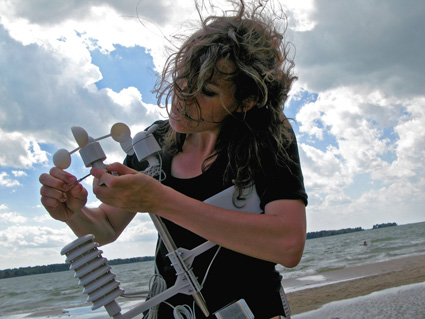
Agnes Meyer-Brandis is fixing pieces of the weather station in the Scarabeus island in SIberia. The sky was cloudy and and the wind was blowing almost 14 m/s just an hour before the total eclipse. Photo credit, Ulla Taipale
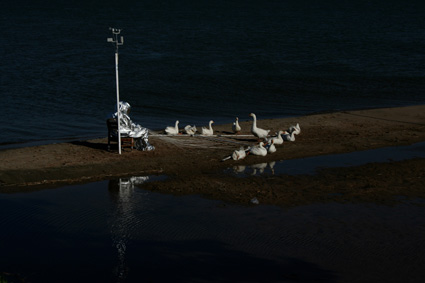
After the first touch, contact of moon and sun at 16.45, the geese stayed calm and Luba, the parachutist got ready for the Moon flight. Image: Agnes Meyer-Brandis
What can artists bring to the vision and experience of natural phenomenon which have already been widely studied by scientists?
A scientist follows his/hers paths of research and an artist his/hers, and both can achieve surprising findings in the same object of investigation. In the end, Curated Expeditions is not trying to gain results that would have scientific importance. The objective is to bring together artists and scientists to work at the intersection of different disciplines, but the results are art works and don’t have to contribute to scientific studies about natural phenomena. What I would like them to contribute is to the recognition of small and big miracles of nature and consciousness about its extraordinariness.
I like the way that Ian McKeever, the english artist, describes the work of scientific and artistic researcher in his text from “Ikijää – Permafrost” (edited by Marketta Seppälä and Yrjö Haila) :
At the moment all us “expeditioners” are “unzipping” the material gathered during the journey- photographs, drawings, videos, writings, and impressions that we lived during this cross-disciplinary expedition. Little by little the final artworks and the ways to present the fruits of the expedition are taking form, the reflections and ideas get processed in our minds. The three proposals were materialized and they are now in progress, the end is not determined.
Talking about visions, I would be very content, if, inspired by these and future proposals, the audience would let their imagination fly a bit further and travel along the migrating birds in the sky to new, surprising destinies, and, instead of purchasing a low cost flight to do shopping in a nearby European country someone would take his bicycle and see what adventures can be lived in the next village. These are some examples of different thinking that the artists could bring to our techno-scientific society where even natural phenomena is tried to be explained and reasoned.
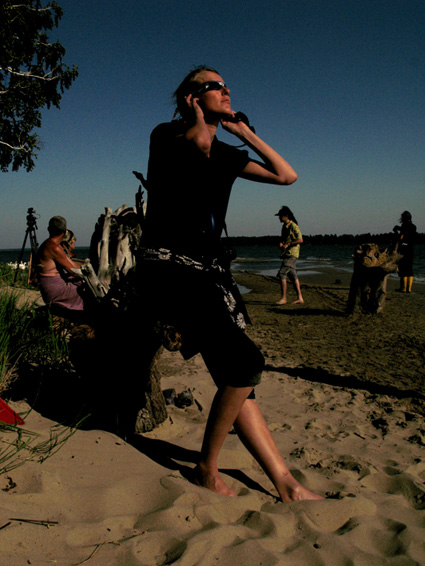
Ulla Taipale in Siberian Scarabeus island, in the strange light during the moment of totality, that lasted 2 minutes 20 seconds, at 17.45 pm. Image Capsula, author unknown
Now that you are back from these adventures, which conclusions do you draw from the experience? What did you learn from the first curated expedition?
It is extremely hard to work with a tiny budget in a country where you don´t know the language and have to depend on many volunteers help. But it is really rewarding when suddenly you discover a bunch of people who are willing and motivated to help you and share the vision that has inspired you to go so far. We can´t thank enough of all the people who helped us in Novosibirsk and during the year to prepare everything. The success of the project was depending on their collaboration. The next expeditions hopefully have bigger budget, but, at the same time I would love to be able to collaborate with local people where ever these projects will happen. Sometimes big resources cause certain distance to the place where you go, the production is taken care of by a professional crew and personal contacts with ordinary people of the locality are lacking. That can be extremely called “cultural colonialism”. I wish to continue Curated Expeditions with the possibility to experience these real meetings with local people.
Despite certain difficulties during the preparation phase of the projects, the artists have shown big talent, imagination and capacity of improvisation to get everything ready for the 1st August when the solar total eclipse happened.
What are Capsula’s upcoming projects?
The Moon Goose Experiment, Zoolar Eclipse and The Journey to the Eclipse will be shown for the first time in Helsinki, Finland, in March 2009, in the Museum of Contemporary Art Kiasma. The show is called “Expedition to the Total Eclipse” and organised as a part of Pixelache09 Festival activities that will consist of an exhibition, (from 6th March until 7th June, 2009), a seminar and some extra activities in the astronomical observatory of URSA. I am invited to stay as a resident in HIAP production residency during February and live in a fortress island Suomenlinna, close to Helsinki centre.
The second Curated Expedition, that will be related to the Baltic Sea, is being maturated at the moment and Capsula is also involved in activities that the Finnish Society of Bioart is organising in Kilpisjärvi Biological Station in Lapland during 2009. Their focus is in arctic biology, climatic and environmental changes and their artistic exploration. The news of Capsula will be published on the website and through the blog.
The next total solar eclipse will occur in India and China in 22nd July, 2009.
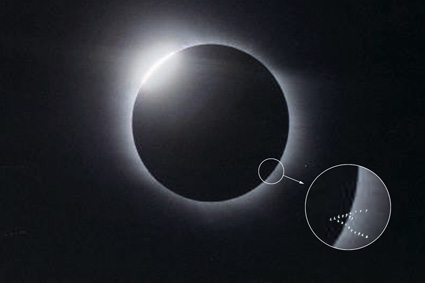
Rare Moon Geese are getting close to the Moon during the total eclipse. Image credit: Agnes Meyer-Brandis
Capsula´s Curated Expedition has received support from:
Zoo of Novosibirsk, FRAME Finnish Fund for Art Exchange, AECID (Agencia Española de Cooperación Internacional para el Desarrollo), VR (Finnish Railways), Venäjän ja Itä-Euroopan Instituutti (The Institute for Russia and Eastern Europe), Finnish Embassy in Moscow, Generalkonsulat der Bundesrepublik Deutschland in Nowosibirsk (General Consulate of the Federal Republic of Germany in Novosibirsk), A MINIMA magazine, Agrupación Astronómica de Sabadell (Spain), AirBerlin, Helsinki University – Kilpisjärvi Biological Station (Finland), University of Art & Design, Pori Department (Finland) , ARPI – professional photostore (Barcelona), NCCA Ekaterinburg (National Centre for Contemporanean Art, Russia), Colección Sabater Pi (Barcelona), Korkeasaari Zoo (Helsinki), SAS Royal Hotel (Helsinki), Sodexo Oy / Hostel Satakuntatalo (Helsinki), Antares Ltd (Barcelona), Fire Department Cologne, Tesimax (Germany), HMKV Dortmund
The exhibition “Expedition to the total eclipse” has received support from:
Pixelache09, Kiasma, HIAP (Helsinki International Artist-in-residence Programme), AVEK (The Promotion Centre for Audiovisual Culture in Finland), Taiteen Keskustoimikunta (Finnish Art Council)
Special thanks for Anneli Ojala from The Institute for Russia and Eastern Europe for translating the Zoolar Eclipse postcards in Finnish!
Thanks Ulla!
I can’t think of any artist who manages to outdo Adam Zaretsky in the art of combining a somewhat comical approach with a keen reflection on the legal, ethical and social implications of new biotechnological materials and methods.
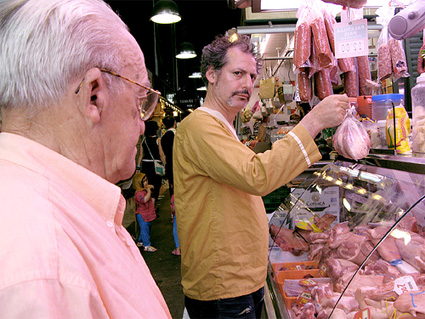
Adam Zaretsky buys a pig heart at the Boqueria food market in Barcelona. Image credit, Capsula
Zarestsky has co-habited during one week in a terrarium with E. Coli bacteria, worms, plant, fish, frogs, mice, flies and the lovely yeast. He has dedicated part of his research at the Massachusetts Institute of Technology to paying Engelbert Humperdinck‘s Greatest Hits to fermenting E.Coli continuously for 48 hours and observing the impact the music had on the bacteria. In case you’ve never heard of this romantic singer, let me spoil your day with a video of one of his smashing melodies:
Zaretsky is a a bioartist, performer, researcher and art theorist whose work focuses on Biology and Art Wet Lab Practice. He has been lecturing and doing research in some of the most prestigious institutes around the world, including the MIT’s Department of Biology, the Conceptual/Information Arts department at San Francisco State University, SymbioticA at The University of Western Australia and at the Rensselaer Polytechnic Institute in the Integrated Electronic Arts Department.
As you might remember, Zaretsky teaches Vivoarts, an emerging and politically charged field that brings together art and biology, at the University of Leiden (NL.) The Vivoarts: Biology and Art Studio course explores the intersection between art and biology and discusses the many cultural issues involved in bioart -and more generally in the field of life sciences- through a blend of hands-on laboratory protocols, critical readings, and the production of contemporary artwork. The ethics of producing living art are debated and made more tangible and understandable by the use of living material/organisms into the class final projects.
I posted it last year already but in case you haven’t seen it yet, here’s ‘Dangerous Liaisons’, a short documentary on his class at Leiden University:
Zaretsky believes that we should “embrace our visceral and experimental mutant kindred. Life is not perfectionism. Life includes the open, onanistic and seemingly unacceptable faces of radical variation.” As he states:
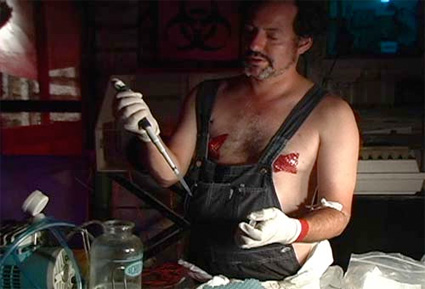
powerFARM :: Woodstock, NY. Adding DMSO for Crypreservation. Still from video
I had the pleasure to share panels with Adam Zaretsky several times. The most recent was Media Art in the Age of Transgenics, Cloning, and Genomics, an event that the lovely rhizome people had invited me to curate. Now that i’ve finally recovered from the surprise he made us by starting his presentation with an extract from a biotech porn video he was working on, i feel that it is high time to 1. invent an opportunity to share another glorious event with him somewhere on this planet before it implodes 2. blog an online Q & A i had with him so that you can get to know him better. I focused this short interview on the work he has been doing in The Netherlands.
The experiments you describe in the video took place in the context of an avian embryology lab for non-scientists at Leiden University. How much knowledge did the participants have of biotech before they entered the lab room? What was their background? Does it take a long time before they can ‘get their hands’ into the genome?
The VivoArts : Art and Biology Studio Honors Class at Leiden was the first of its kind in the Netherlands. Since my class another Art and Biology Course has been taught at Leiden U. by Jennifer Willet and in April the third version will be taught by Caitlin Berrigan starting spring 2009 (so sign up now.)
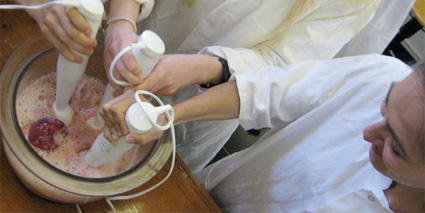
DNA extraction in class. Image
Thanks go out to Prof. dr. Robert Zwijnenberg of The Arts and Genomics Centre for investing time and brave direction to make these courses a reality and for organizing the breadth of disciplines being exposed to this sort of Bioethics Art Practice. The participants were from Art History, Sociology, Philosophy, Biology and even Theology… But, there is no Art Studio practice degree at Leiden U. so we put out the word and a few artists applied or just showed up.
The simple answer to your first question is, no experience is necessary. All Vivoarts labs are hands on labs for the untrained. I guess it’s a sort of biology brut or outsider biology. Informed opinions on present-day and near-future bioethical conundrums are more readily coaxed out of non-biologists through a hands on approach. It takes time to get approval to teach non-professionals and students whose focus is not biology or bioethics. After clearance, the students can come in with zero experience and leave having made time-based, hybrid, new media, wet-lab, living arts pieces: transgenic embryo sculptures, GMO bacterial paintings and/or tissue cultured embryonic stem cell totemic fetish objects.
There were some reticent parties on campus. They claimed that they were worried their patients might be afraid that artists a la Moreau were treating them. (…) I think that the reaction to an art class in the lab doing ‘important’ transgenic embryology work in the name of non-utilitarian, ‘frivolous’ artistry reflects a fear of demystification of transgenic process. Is the fear of attention given to playful transgenic embryological research procedures limited to wariness to contend with animal rights advocates often knee-jerk responses? Or, is it because often enough, well-funded Transgenesis research is as equally ‘useless’ or has just as little chance of producing important data as a hands-on Transgenic Developmental Biology Embryological Sculpting Lab for Social Commentary. But, these balkers are University researchers. Why hide from eager students in a castle of learning? Transgenic human production is a contentious cultural issue that is in need of interdisciplinary research before it goes to market. If we want an informed public to help us gauge the eventual results of aesthetic human engineering, we need people with experience who have their own ideas about the process, the results and the price of genetic tinkering.
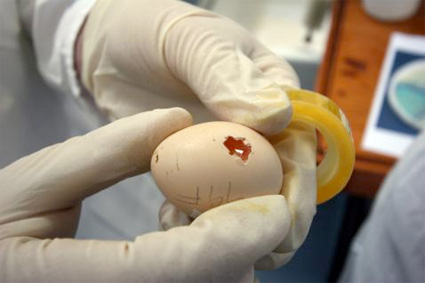
Photo from the Transgenic Pheasant Embryology Lab, credits to Jennifer Willet from Bioteknica
You mention in some of the written documents that plasmid injections were made with homemade tools. Hackers and amateurs around the world are experimenting with technology in a creative way as part of a broad DIY culture. Do you think that this DIY approach could apply to biotech art experimentations like the ones you perform? Where are the limits?
About half of my labs are 100% DIY. A lot of the Art and Biology crew are interested in the demystification of technology. The dorkbot skillshare mentality is more than a hot geek dating service. It’s about showing that the technology, in this case biotechnology, is comprehensible and actuate-able with home brew strategies and some kitchen sterile technique.
For instance, the microinjectors for our embryology lab were made of glass pipettes pulled over a flame into small-bore needles. The plasmid was literally sucked up and hand pressed into the living embryos. We squirted into the embryos. The hope was that the microinjection needles were smaller than the embryonic nuclei and that, without microscopes, the plasmid would be injected or find its way into some nuclei for incorporation into the genome of the unborn pheasants.
This is not how an embryologist would work. The odds of success are already low without such haphazard application technique. Expensive machines are used to pull glass needles of the exact bore which will penetrate the nuclei of the organism of choice (mouse, rat, human, frog or fly embryos for instance.) Injections ‘usually’ occur through the microscope and XYZ microcontrollers guide the payload into the organism with finesse and acuity. Microinjectors cost over 100,000 euro and are not usually available to the general public (although I did use one at MIT to inject wasabi and cream cheese into Tobiko.
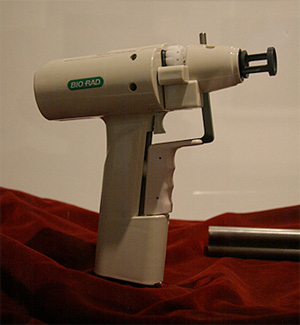 But less accurate methods like gene guns or direct injection of DNA are also used in today’s gene therapy trials. These human trials, which may be producing germline alterations, emphasize the porousness of our collective genome. The history of embryology is built on cheap contraptions and closet incubators. Look at chicken breeders, both their social status and their successes. How many of them used strange feed or other ‘pushing of life’ techniques to make their prizewinning mutants?
But less accurate methods like gene guns or direct injection of DNA are also used in today’s gene therapy trials. These human trials, which may be producing germline alterations, emphasize the porousness of our collective genome. The history of embryology is built on cheap contraptions and closet incubators. Look at chicken breeders, both their social status and their successes. How many of them used strange feed or other ‘pushing of life’ techniques to make their prizewinning mutants?
So, I would say that persistence will outweigh the technological edge especially because no one has any idea of what life is, what the future holds and what the long term effects of even supposedly ‘controlled’ experiments will have on ecology, living being and the concept of species integrity. As far as I can tell, a tattoo gun with a single point needle dipped in the right plasmid concoction might be a great nano-transfectant for the lotek-biotech artist who still likes to draw. If it takes a lot of microinjections to get success when working blind… then gene tattooing is the way to go. (You could also buy a cheap microscope and improve your odds at least 30X.)
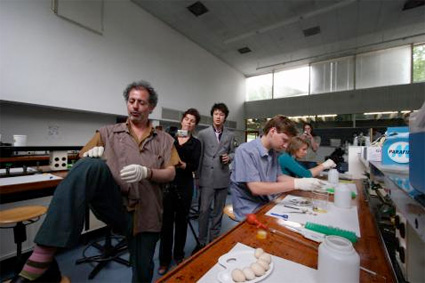
Photos from the Transgenic Pheasant Embryology Lab, credits to Jennifer Willet from Bioteknica
(Warning: Gene insertion may eventually cure cancer but right now it can also cause cancer. (i.e. Leukemia, see the case of Jesse Gelsinger).
Now, when it comes to DNA sequencing and plasmid design, this is just starting to be a tabletop possibility with cheaper sequencers and biobrick sets from the megaMaterialists over in Synthetic Biology. But, the learning curve is steep and can be expensive if you don’t want to work with ready-mades. Designing your future pet’s body plan or your own prehensile tail or an extra brain in your lovely daughter’s derriere… that will take some trial and error. The effect is not just material. The genes are multifactorial. We haven’t a clue as to what metabolism is. We can’t even distinguish between enhancement and a living curse. But still, I’m hopeful.
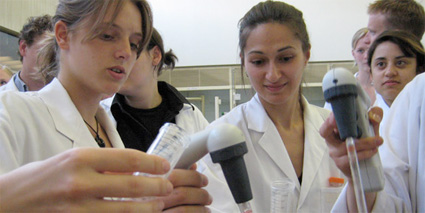
DNA extraction in class. Image
The lab obviously triggered many questions and debates. One of them drew a thought-provoking parallel between animal research and animal sacrifice, a pratique which nowadays seems outdated and almost barbarian. I know that you are careful to comply with legal limits and are deeply concerned with the ethics of what you are doing and preaching. But did you mention this parallel between sacrifice and research in order to highlight the more sinister aspects of research? What are the most sobresalient points of the research/sacrifice debate that took place among the participants of your class?
First I wrote this:
Funerals Rites for Transgenic Pheasants: Rituals of Bio-Art Practice
Some artists are utilizing lab technique as a new medium to produce living and often mutant living art forms. As these ‘sculptures’ live and die, often at the whims of the artistic investigator, the personal, non-repeatable moments take on a ritual air. What kinds of rituals do interdisciplinary Art and Biology practices entail? How do they reveal the implicit rituals of science? What new performative rites come out of mixing ethics and esthetics in the laboratory? Scientists also have their methodologies of creative flourish and humane sacrifice. But, scientific and artistic play is often based on different paradigms of what the act of experimentation is. As artists learn laboratory technique, the rituals of science and new rituals of sci-art unfold, decouple and reconfirm magical thinking in both arenas. How does animal research relate to the history of animal sacrifice? What is the role of subjectivity in developmental embryology? Is transgenic protocol also a ritual for the cultural production of liminal monsters? And how does mutagenesis impede or coerce the imaginary in the lifeworld? Through an analysis of artists confronted with the responsibility of ending the life of transgenic pheasant embryos, (which they had altered with plasmids in the name of art,) I hope to show living rituals for new biotechnological processes as they are invented.
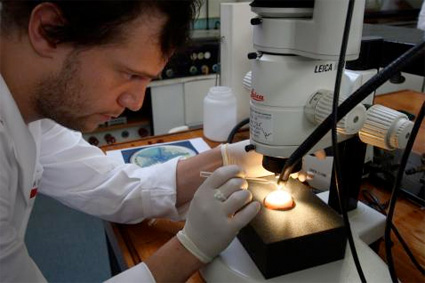
Photos from the Transgenic Pheasant Embryology Lab, credits to Jennifer Willet from Bioteknica
But to be more down to earth, this is complicated and needs regular talk too. First of all the students were guaranteed a good grade even if they choose to be ethical observers. So there was no pressure to be hands on. Secondly, methods of humane sacrifice were discussed even if the concept is an oxymoron. Legally, embryonic birds are not organisms in Europe. What they really are is unclassifiable, but they are not free living nor do they have fully developed nervous systems. So they are conceived to be dim or not fully on. They may be thought of as a group of cells on the way to becoming a full-fledged, free-living organism. For this reason, they do not have rights in any way nor do they have a single preferred humane sacrifice method. Actually, humane sacrifice is not a prerequisite in embryonic end of life issues.
Of the scientists I quizzed, the methods of sacrifice commonly applied were death by: autoclave, refrigeration, put down on ice or poured down the drain. I added to other options for my students: valium overdose or ritual sacrifice. The valium overdose was my idea of the most humane sacrifice for an embryo. It may have been the first time that an embryo was given such a respectful euthanasia. But, the ritual sacrifice option was wide open and I can tell you that we are still living in barbaric times.
Also, I offered to play executioner for my students. Often I had to not just respect their choices but enact them. It was a horrific part of the lab for me. But, I did learn a lot. I wouldn’t dismiss the value of sacrifice in science, religion or even secular posthumanism. Some rituals were moving funerals about the traumatic pasts of the slayers. Some underscored visions of techno-obliteration, the War Machine (Critical Art Ensemble, see the first chapter of The Flesh Machine), which accounts for way too much of the world’s economic and productive focus. Some of them were heartless and natural and sincere. One student’s acts even inspired remorse for outsourcing an incineration. It is as if serial killing and bureaucracy were still strange bedfellows. All and all, the sacrifices were conducted in a responsible way even if they were non-utilitarian. The lab showed the range of human behavior when dealing with GMO snuff issues and unborn politics and it gave experience of the viscerality of transgenic process to the students.
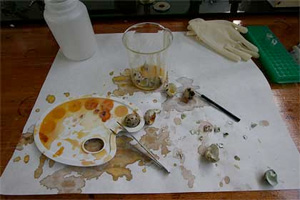 Photo from the Transgenic Pheasant Embryology Lab, credits to Jennifer Willet from Bioteknica
Photo from the Transgenic Pheasant Embryology Lab, credits to Jennifer Willet from Bioteknica
To be quite frank and honest, I am still in a strange state of being torn around these issues. I think abortion should be legal and believe in a woman’s right to choose. Yet, I believe in embryonic isness: that there is something dignified about a developing organism. I am anti-war and think capital punishment should be abolished. I support some animal research as I have seen results that do help with disease. I do think the focus should be on AIDS and Malaria instead of prostate cancer and new cholesterol blockers. But it is not that simple. Often enough, I approve of experimental curiosity in general. I understand that we have a strange human gymnastic need to scope and poke everything to see how it ‘ticks’ or even just as pornography. I do think most biological research is just in-group magical empiricism but I also think that it is effective in a social cohesive sense. So, I guess I am old fashioned when it comes to ritual sacrifice even with a lab coat shaman behind the lab doors. Nonetheless, we humans could be less nationalist and provide global food, shelter, clean water, free rent and a ‘work-optional’ baseline to all humans. And, if you believe the news, many Bioart practitioners, myself included, lay claim to a sort of relational bent, attempting to go beyond anthropocentrism in the name of respect for the non-human actants of the earth. That is, many of us do consider all life to have an existential specialty which is their own and which is often superior to Homo sapiens narcissism in diverse ways of niche working and play. Yes, if we have it in us, we need to give back a lot of the land mass we have ‘cultivated’ on the crust of this planet to non-humans for their rights to freedom, space and daytime walks. But when it comes to embryos, I admit, I eat bunches of them on a weekly basis: caviar, eggs, raw seeds, grain, and bean sprouts. Being alive is a sort of hypocritical stance.
We cannot apologize to the organisms we use, even our flowers after death, because I doubt they would accept an apology. We cannot thank them, as some of the native peoples of the Americas still do, for providing us dinner or art materials, because I doubt they would say ‘you were welcome.’ In a sort of Taoist or Fatalist sense, we can try to welcome the hunger of the living consumers of our living and hence dying bodies (whether they be human, other animal, vegetable, bacterial, insectoid, fruity or fungal) as they come to feast on our inevitable temporary-ness, our becoming food for others. For this reason, I am anti-embalming and believe in green burials as we are just mulch in the long-term sense. In the short term we are entropic, greedy, sensual, hungry holes in need of sustainable release through passionate spectacle. (see my video Retool Earth.)
I often refer to this type of trial by fire lab as a Milgram Experiment without authority. I proclaim myself an amateur, I give the option to not participate and yet, when given the legal thumbs up, most people will do what they know is ethically tarnished. At the same time, fear of implication in the lifeworld, shame of causing death in general, while causing death, is more dangerous than modern primitivism. The Nobility of Neurosis (J.G. Ballard re/Search) is part and parcel to the Latourian concept of modern distinction as a farce. So, although I wish the Hague War Crimes Tribunal had authority over the nation I live in which has no respect for the Geneva Convention, the Nurenberg Code or the Declaration of Helsinki, fertile eggs are still a popular food particularly in green non-vegan circles. A well-made fertile egg omelette is no casual funereal ritual. Baroque and gourmet productions take time and the nuance and the taste is not lost on the pallete.
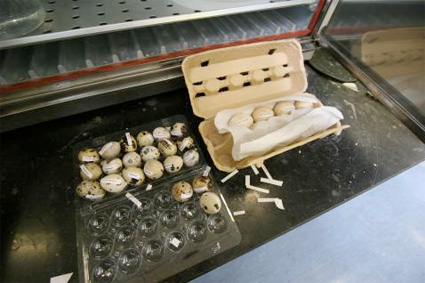
Just to underscore that I am thinking while acting the clown…
The fertile eggs were named during incubation. This is a list of their names:
Health, Beauty, Longevity, Public Good, Knowledge, Profit, Erotism, Utility, Novelty, Animal, Poor, Queer, Captive, Slave, Fat, Ugly, Short, Stupid, Primitive, Unborn, Deformed, Poor in the World, Raw Material, Extinguish Humanely, Expendable Being, Educational Embryo, Pity Party, Defect, Murder Me, Loss and Lack, Death Row, Dead End, Destiny, Non-Being, Non-Human, Sub-Human, Pre-Human, Ancestor Rape, Use Me, Material, Fratricide, Torture Mirror, Somatic Machine, Responsive Behavior, Model Organism, Reflex Entity, Workhorse and Factory.
One of your documents mention a project in Spain? Why Spain? And where exactly would you like to perform new researches? Can you tell us briefly what this project would be about?
Actually, I talked to Marta de Menezes of Ectopia in Portugal (another Bioart Residency to look into) and she said that Bull Fights, the Politics of Primitive Tradition versus the Elimination of any Appearance of Injustice and Bull Sperm Sorting for Breeder Profit (transgenic as all hell) were all popular pastimes in Spain. So if I was in Spain or Portugal, I might like to look for some off target mutations in the garbage bin of a major Bull Sperm Sorting outpost. Really, the FACS Bucket text was just an idea for a residency that ended up getting published in Portugal. Due to parenting responsibilities, I can’t spend more than two or three months a year outside of the US. The WAAG Society and The Mondriaan Foundation have decided to host/sponsor a public course and performance over the next year in Amsterdam. I would also like to work on making more transgenic pheasant embryos so I can fine tune my imaging and maybe even discover something that might make a reductionist out of my otherwise sticky fingers. I am looking for more funding so send money people to Lucas Evers
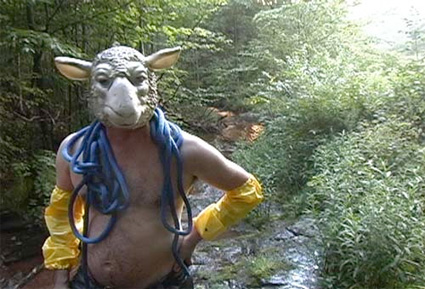
pSHEEP, screenshot from pFARM
Right now, I live in the Catskill Mountains of New York, Woodstock, USA. I am gearing up to initiate VASTAL: The VivoArts School for Transgenic Aesthetics Ltd. I would prefer it function independently of any university so it would be obscure, DIY and edgy. But this would need a real budget even for a two-year planned obsolescence trip. I also consider pFARM to be conceptually ready to make the move to something more than a small collective. The Organic Biotech Fetish Farm has started to attract devotees and as a cult grows, so must its infrastructure. We are still accepting applicants on subservient grassroots level at this time. Although I have traveled widely, I ask myself which other nation is there that deserves the kind of lessons I mete out. I can smell the Ku Klux Klan hay in every corner of the world markets but the USA has taken Superpower-Slumlord to a new low. So, I figure New York is my tropical island in which to experiment with human volunteers and their gonads… VASTAL 2010 … Know any strange hosts?
I wish i did. Thanks Adam!
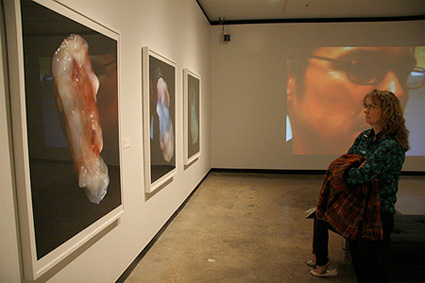
Transgenic embryo prints as exhibited at Imagining Science Exhibition, Art Gallery of Alberta, 2008-2009
In the news: Adam Zarestky is participating to the show Imagining Science that runs through February 1, 2009 at the Art Gallery of Alberta. Zaretsky and The pFARM Collective are part of the exhibition Corpus Extremus which opens in February 2009 at Exit Art in NYc. The book Imagining Science: Art, Science, and Social Change has won an award in the 2009 New York Book Show in the Scholarly & Professional category.
The largest part of the pharmaceuticals and chemicals we take go through our bodies and eventually end up in waste water. As water and waste treatment plants haven’t been designed to filter them, the content of our medicine cabinets are eventually passed into the water supply. In London, tap water comes from surface water which implies that traces of our medicine can end up in our drinking water. This results in local differences in tap water, based on the food and drugs we ingest.
Tuur van Balen, one of the graduates of Design Interactions at the RCA, decided to explore this issue in a project which imho had the perfect balance between speculation and solid anchorage into reality.
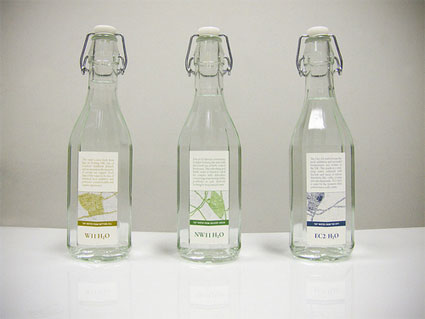
The way people live and behave in each zone of London can be reflected in the quality of the tap water. Tap water in London Notting Hill very probably benefits from the high density of organic shops found in the area. Tap water in the city of London is presumably enhanced with all kinds of stimulants, from caffeine-rich drinks to cocaine. Golders Green which houses an important Jewish community can be expected to ‘produce’ a very fertile water due to the low concentration of people taking anti-conception pills.
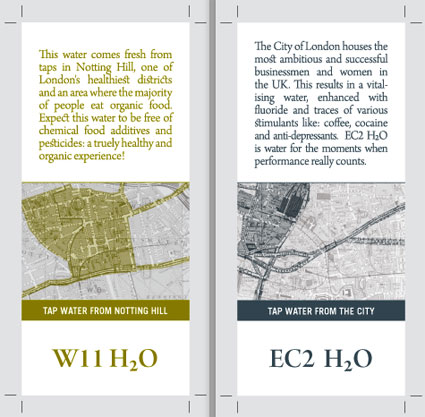
Back in January, at the opening of the department work in progress show, Tuur presented My City = My Body, the first chapter of this research into future biological interactions with the city and more precisely into how the increasing understanding of our DNA and the rise of bio-technologies will change the way we interact with each other and our urban environment. He offered tap water to the visitors of the show and asked them to donate a urine sample along with their postcode. The samples, their biological information and postcodes were then added to a map of London which reveals potential local city-body ecologies or biotopes.
The next step is a website which helps London inhabitants describe, speculate on, map and share what they think are the unique characteristics of their tap water. The map thus created reveals potential local city-body ecologies, or biotopes. The system will also generate a custom-made label which you can download if you want to sell your own tap water.
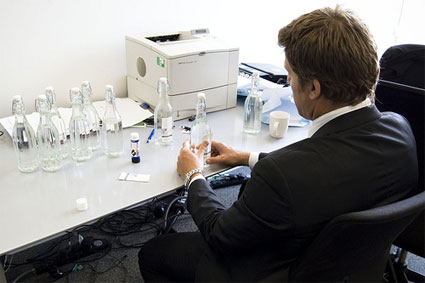
Filling the bottles in the City…
That’s what the designer did. He went to the hip and organic-addicts frequented Broadway market in Hackney to set up a stall, offer people to “buy” bottles of tap waters, branded with the London area they came from and engage in a discussion about the possibility of new urban biotopes.
selling tap water on Broadway Market from Tuur Van Balen on Vimeo.
You can find various websites which details the quality of various tap waters. But most of the systems employed to analyze water do not check for say, anti-depressant substances or cocaine. What if biotechnology could provide us with cheap detectors?
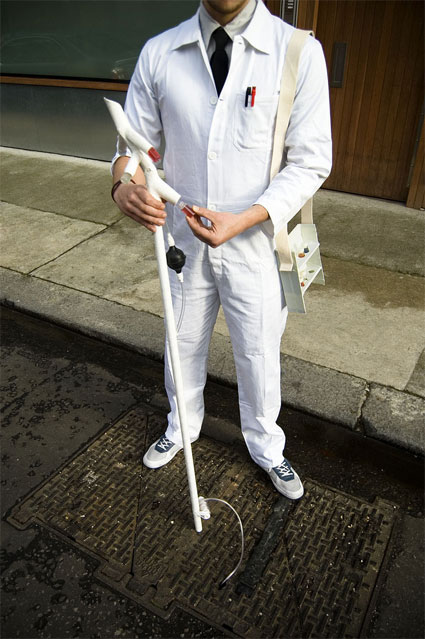
With the help of bioengineer James Chappell, Imperial College, Tuur developed the concept for a Urban Biogeography tool. The instrument would enable anyone to study the distribution of urban biodiversity over space and time by monitoring sewage. With the tool, a tiny amount of sewage can be pumped up and scaned for different pharmaceutical and chemical traces, without having to lift a manhole cover.
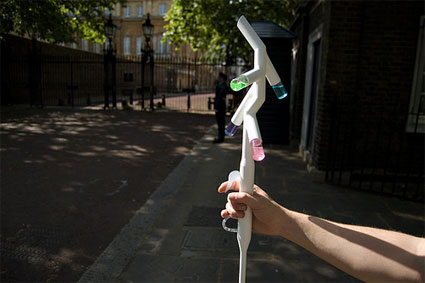
Using synthetic biology and in particular the biobricks tools, bacteria are programmed to become cheap biosensors. The bacteria-sensors, housed in the small transparent compartments, change colour when oestrogen, antibiotics, Viagra or Prozac are detected in the water. Since synthetic biology is both open source and modular, this instrument can be redesigned to detect other chemicals by any Urban Biogeographer, even amateurs as the technology is becoming increasingly accessible. The set of data thus obtained can be used to influence healthcare or property prices in the area, that of course would be the ideal scenario…
All images courtesy of Tuur van Balen.
Related: 24c3: Programming DNA – A 2-bit language for engineering biology, Designer Microbes.
Instead of following my natural instinct and turn this blog into the usual happy bordello where unrelated posts follow one another, i’m going to try and focus my reports over the next few days on the projects i saw last week at the RCA Graduate Summer Show in London.
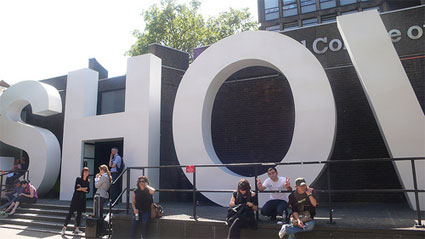
Revital Cohen‘s final project at the Design Interactions department looked at how cross-breeding man with machines or other species can open up new design opportunities and a space for debate (see her previous project the Telepresence Frame.) I realize that most of the readers are familiar with this concept of ‘design for debate’ but to avoid any misunderstanding, let’s just remind that design for debate explores how design can be used as a medium to draw attention to the social, cultural and ethical implications of new technologies. The resulting design proposals do not provide answers, but they make complex issues tangible, and therefore debatable (via).
Revital’s Life Support project looks for way of disconnecting people from the therapeutic machines and cold technologies they are harnessed to. Assistance animals – from guide dogs to psychiatric service dogs and other emotional support animals – unlike machines, can establish a natural symbiosis with the patients who rely on them. Would it be possible to go a step further and transform animals into medical devices?
This project proposes using animals usually bred commercially for consumption or entertainment as companions and providers of external organ replacement, offering an alternative to inhumane medical therapies.
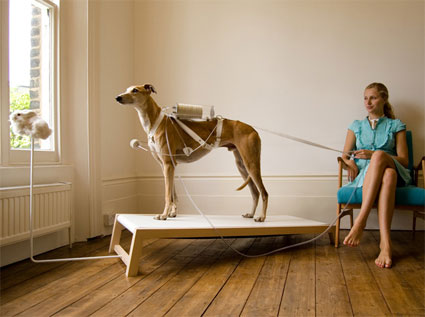
The first part of the project revolves around a concept of Respiratory Dog. Today greyhound racing remains a very lucrative business. Tens of thousands of these dogs are bred annually in an attempt to create the fastest dogs. Most of them are killed if at any time it is determined that they don’t have potential to be good racers. The dogs are a mere commercial product and because they constitute a major expense, many of them are killed as soon as it is determined that they don’t have value anymore as a racer at a track.
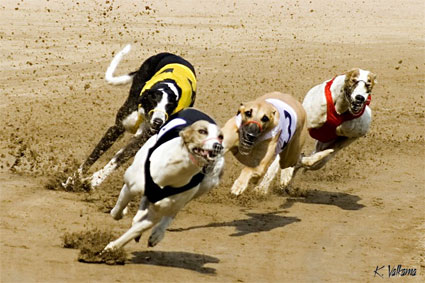
Greyhound race. Image Valkama
In 2003 alone, an estimated 7,500 to 20,000 greyhounds were euthanized simply because they couldn’t run fast enough. There are more heart-breaking (even for me who could never be accused of being dog’s best friend) facts about their sad existence on the PETA website.
In Revital’s scenario, a pedigreed greyhound spends the first twelve months of his life being trained by the racing industry to chase a lure. Over the next three to five years the dog spends his days at kennels and is taken racing weekly to make profit for its owners.
So far, nothing new. However, as soon as its time has come to retire from the racetracks, the greyhound is not euthanised (as happens nowadays to thousands of retired greyhounds), it is collected by the NHS and goes through complimentary training in order to become a respiratory assistance dog.
When training is completed, the greyhound is adopted by a patient dependent on mechanical ventilation and begins a second career as a respiratory ‘device’. The greyhound and its new owner develop a relationship of mutual reliance through keeping each other alive.
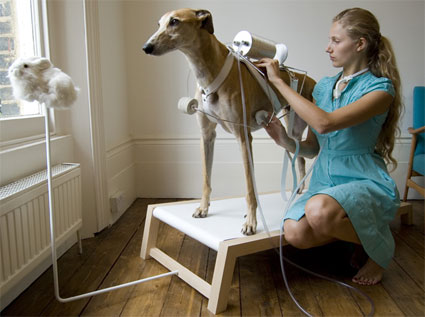
A new apparatus is used to converts the greyhound’s lung movement into mechanical ventilation: the dog is fitted with a harness and placed on a treadmill where it will start running, stimulated by the same mechanical lure employed in its previous training. The treadmill functions as the interface and on/off switch. The harness uses the dog’s rapid chest movement to pump a bellows that pushes air into the patient’s lungs.
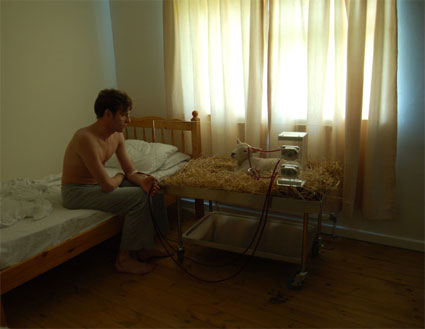
A second scenario envisions substituting a dialysis machine with a sheep. The concept is inspired by several advances of science such as the creation of cows and sheep cloned to have human blood in their bodies. Much research is also carried out to design animals which would carry organs compatible with humans. When one organ would be needed for transplantation the animal would probably be killed to provide the precious body part.
On the other hand, current, mechanical, dialysis treatments are far from being perfect.
Revital’s scenario imagine that, in the future, a patient suffering from kidney failure would give a blood sample to lab scientists who then isolate in the genome the regions that code for blood production (bone marrow tissues), and immune response (the major histocompatibility complex), extract the genome from the nucleus of a somatic cell taken from a sheep and substitute the corresponding regions of the sheep’s genome with the DNA from the patients’ genome.
This recombinant DNA is then inserted into the nucleus of a pre-prepared sheep egg cell. After cell division in the egg is initiated, the egg is implanted into a surrogate ewe which will eventually give birth to a transgenic lamb.
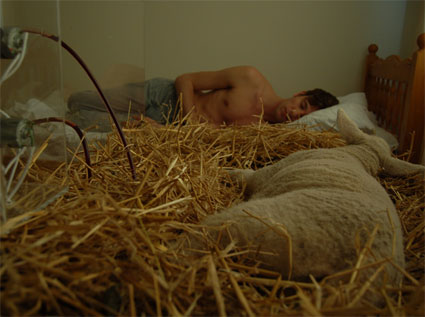
During the day, the dialysis sheep roams in the donor patient’s back garden, grazes to cleanse its kidneys, and drinks water containing salt minerals, calcium and glucose.
At night, the sheep is placed at the patient’s bedside. The transgenic sheep’s kidneys are connected via blood lines to the patient’s fistula (a surgically enlarged vein). During the night, waste products from the patient’s blood are pumped out of the body, filtered through the sheep’s kidney and the blood is returned, cleaned, to the patient.
This happens over and over again throughout the night. The day after, the sheep urinates the toxins.
Related: Utility Pets, myBio dolls, The Race, health benefits of robotic pets.
Back in July, while i was visiting Documenta 12 in Kassel, i saw a 16-metre-long flower-bed raised above the ground, with 70 packets of seeds sprouting from the grass, each of them carrying worrying labels that documented the latest form of Colonialism: biopiracy.
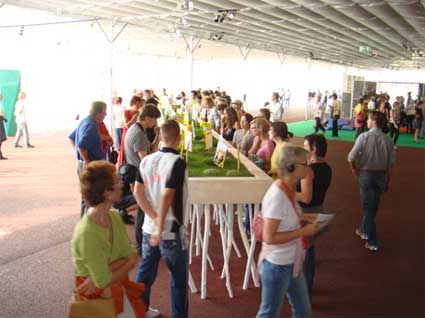
Photo documenta 12
Biopiracy describes a new form of “colonial pillaging” in which western corporations reap profits by taking out patents on indigenous plants, food, local knowledge, human tissues and drugs from developing countries and turning them into lucrative products. Only in few cases are the benefits shared with the country of origin.
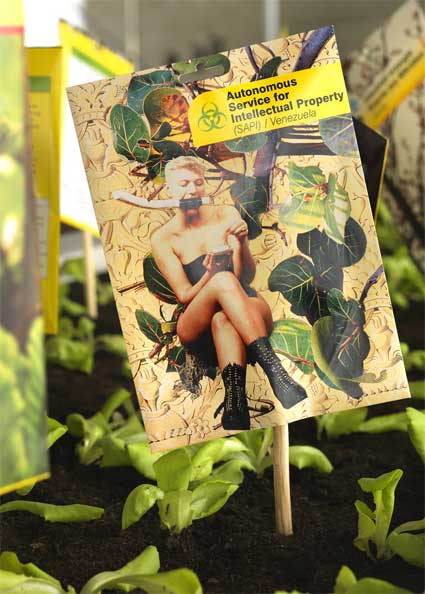
Biopiracy targets particularly countries known for their exceptionally high level of cultural and biological variety: Mexico, India, Brazil, Indonesia and Australia. This process is also referred to as “internal conquest” in analogy to the “external conquest” of colonialism.
In her Siegesgärten (Victory gardens, 2007) installation, Vienna artist Ines Doujak criticized the bio-politics of EU and the USA which turn a blind eye on the ruthless economization of nature and of life. The seed packets sprouting from the flower-bed informed visitors about global exploitation, genetic engineering and monoculture. On the front of the packets are photo-collages showing drag queens and kings and fetish secual practices set in exotic natural settings. On the back, the conditions and consequences of biopiracy are described and illustrated using real examples of the practice.
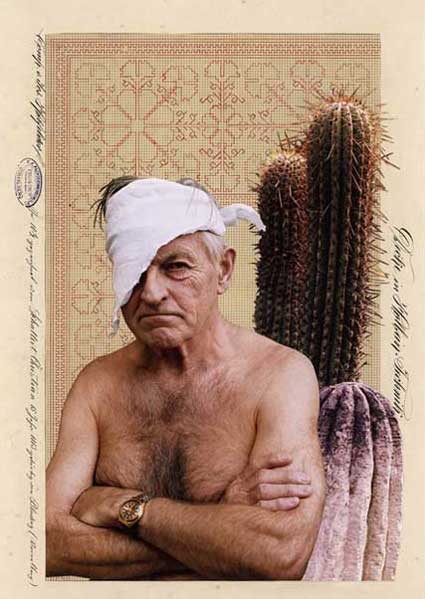
“We fear an increasing dependency on large corporations that seek to control global food production and agriculture by means of patents, from milk to bread and from baking grains to energy plants”, explained patent expert Christoph Then (via no patents on seeds.)
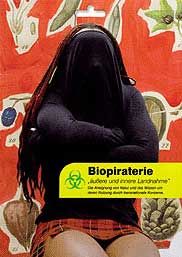
I had kept the artwork somewhere in the back of my mind, feeling that i needed to investigate the matter deeper. Now, Doujak has collected the images and texts relating to her work in a book which is partly in german and partly in english.
This is an eye-opening book (at least for me). I don’t think i’ll ever shop the same way again. Except that it’s not going to be easy. I can boycott a few cosmetics but how could i live without the giant which has been accused of being the “biggest threat to genetic privacy” for its alleged plan to create a searchable database of genetic information: Google? In her book, Doujak retraces many cases of biopiracy, while giving a context for the practice.
In 1980, Ananda Chakrabarty became the first person to receive a patent for a transgenic organism, a bacterium he had engineered to digest oil. Previously, life forms had been excluded from patent laws. The landmark patent has since paved the way for many others on genetically modified micro-organisms and other life forms.
5 years later, the U.S. Patent and Trademark Office allowed GM plants, seeds and plant tissues to be patented. And by 1987 animal patenting followed. Today even human gene sequences, cell lines and stem cells are permitted. Corporate interests can thus corner life forms for the lifetime of a patent and have a monopoly on their exploitation. With the advent of nanotechnology comes the rise of what the Captain Hook Awards call the nanopirates, those who claim ownership of the molecules and even the elements that everything is made from.
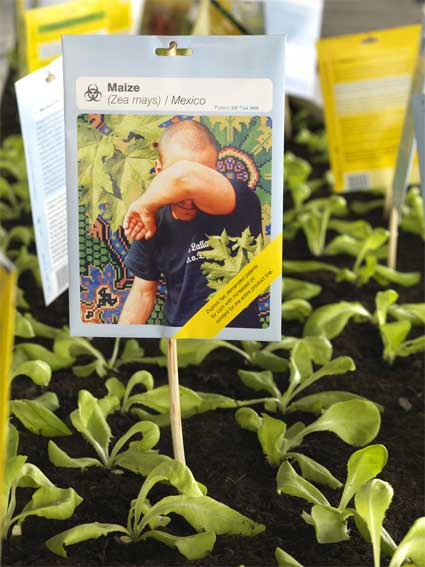
Image documenta 12
As Ines Doujak writes in the book:
The stories collected by the artists are fearsome, here’s just a couple of them:
– Genetic material from members of some indigenous communities in Brazil and Venezuela can be purchased for 85 dollars through the Internet. It is unclear whether the samples were obtained with the full and informed consent of the individuals and of the Brazilian government. Another issue is whether there are guarantees in place to ensure equitable distribution of the knowledge and profits generated from the samples.
– A coalition of indigenous farmers in Peru protests against the multinational corporation Syngenta’s patent for ‘terminator technology’ potatoes. The patent involves a genetic-modification process that ‘switch off’ seed fertility, and can therefore prevent farmers from using, storing and sharing seeds and storage organs such as potato tubers. The Indigenous Coalition Against Biopiracy in the Andes says that by commercialising such potatoes, the corporation would threaten more than 3,000 local potato varieties that form the basis of livelihoods and culture for millions of poor people. They also fear that pollen from the modified potatoes could contaminate local varieties and prevent their tubers from sprouting.
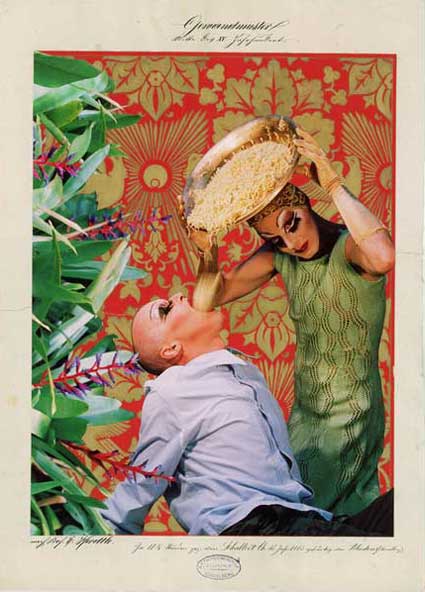
Some of the cases described in the book are comforting, they show how organized action can reverse unfair processes. That’s what happened with quinoa, a plant cultivated in the Andes for 6000 years. In 1994, scientists from Colorado University were granted a patent to a Bolivian species. This means they could also control the rights to any hybrids created using the Apelawa variety, including many traditional varieties grown by peasant farmers in Bolivia, Peru, Ecuador and Chile as well as varieties important in Bolivia’s quinoa export market.
As the president of the Bolivian National Association of Quinoa Producers said at the time: “Our intellectual integrity has been violated by this patent,” he said, “Quinoa has been developed by the Andean agriculturists for millennia, it wasn’t ‘invented’ by researchers in North America.” Protests proved successful: the patent was dropped in 1998.
A second case with annulment of a questionable patent concerns the Hagahai people (Papua New Guinea). Their first contact with the outside world was in 1984. Viruses and illnesses resulted in this contact decimated the Hagahai to such extent that they were under threat of extinction. Foreign researchers administered the vaccination needed but also took some DNA samples (without their knowledge). They discovered that the people is immune to leukaemia and degenerative neurological illnesses. The genetic qualities of the Hagahai were patented in the United States. Worldwide protests led to the annulment of the patent.
More images
from her work at documenta, Kassel.
The reason for my presence at etech08 this year was the “art fest” that i set up with the super nice and super smart Kati London, an itp graduate who currently works as a senior producer at area/code in New York and as an artist responsible for projects such as Botanicalls Twitter DIY and You Are Not Here.
Brady Forrest had the idea to organize this first ETech Emerging Arts Fest and we are infinitely grateful to him. We had our friendly debates and doubts but he is the first person who listened to our complains that artists should be given a voice in all those big technology conferences. The theme of the event was “Awareness” and we selected works that bridged the gap between perception and understanding. In retrospect i realize that Brady selected the geekiest pieces, Kati (who actually did most of the work) chose the playful ones and i went for information visualization.
Kati and i invited Brooke Singer to join us for a panel which attempted to illustrate the whole idea of awareness to the conference attendees. Because i’m never really interested in writing about my own presentations and because i’ve covered the work of Brooke several times (and will keep on doing so in the future), i’ll just focus on Kati’s talk.
She gave me the authorization to publish her slides so here they are:
And here the notes i took while she was talking:
She compared artists to hackers, they are the one giving the one finger salute to mainstream technology, they have ideas, go against the grain and keep on pushing their own inspiration forward no matter the resistance.
Today, we have more and more tools which empower people: OS hardware and software, library, there’s also a revival of the DIY culture, Arduino and Processing are increasingly successful, etc. Suddenly being creative with technology becomes possible for a larger number of people. How does this spirit translate when we think about “awareness”?
Kati then focused on several projects which, according to her, best embody the idea of awareness.
1. Invisible: Waste processes
drinkpeedrinkpeedrinkpee, by Rebecca Bray and Britta Riley, includes an installation and a diy kit for turning your pee into fertilizer for houseplants.

What happens when we think of our bodies as their own ecosystems? Are they open or closed ecosystems? Where do we draw the boundaries? Before we take medication, do we ask ourselves how it will affect our internal organs, our friendly bacteria? What is our medication’s future, beyond our bodies, in the sewage system and out in the waterways we swim in and eventually drink? What are the possible futures of our personal waste? What do sentient ecosystems eat and drink?
Human urine is actually sterile (unlike faeces, it is bacteria-free) and it can be a rich food source if it gets into the right part of the right ecosystem. Now, most human urine travels untreated into the waterways and is a significant cause of eutrophication, a toxic condition caused by harmful algae blooms, in the oceans. The excess nitrogen and phosphorus in our urine overfeeds algae and suffocates fish.
However, a biological waste treatment process developed at EAWAG Aquatic Research in Switzerland can extract this phosphorus & nitrogen for use as a fertilizer, leaving the rest of urine almost harmless to aquatic life. This kit gives users the opportunity to replicate the technique at home and fertilize their plants with their own pee.
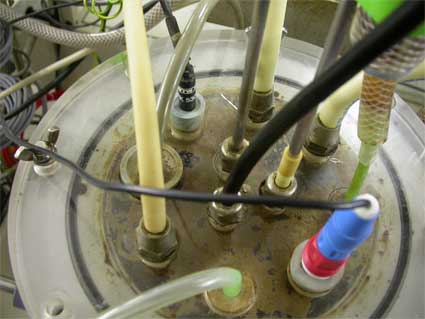
Bioreactor to stabilize urine, photo Eawag
The installation will be on view and the DIY kits will be available at the exhibition FEEDBACK at Eyebeam, March 13 – April 19, 2008.
2. Invisible: Animal Behavior Patterns
Joshua Klein built a vending machine that teaches crows to deposit coins in exchange for peanuts. Crows are surprisingly (for me) intelligent. Their brain/body weight ratios are similar to chimpanzees. Look at the image below, seagulls don’t get the vending machines but those smart little crows seem to understand that there’s something worth their attention there.
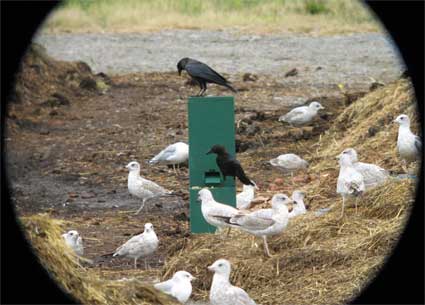
Once he has fine-tuned the vending machine training, his plan is to train crows for search and rescue, picking up trash, and other mutually beneficial tasks (via boing boing). The machine is only the first step in his quest for “interspecies harmony.”
3. Invisible: Social Connections
 Generative Social Networking, by Andrew Schneider and Christian Croft, uncovers the dark sides of social networks by exposing their vulnerability. The software uses bluesnarfing to open the mobile phonebooks of people using security loophole-laden Bluetooth devices. This phonebook data is then fed through the GSN System. Unbeknownst to the phone owner, the device betrays its list of phone numbers to a laptop. An Asterisk phone server will then generate a “conversation” with each number in the list. The first number on the list is called and receiver’s response recorded. The next number on the list is called, the first number’s initial response is played back to the new number, and the new number’s response to the old number’s prompt is recorded. This continues for however many phone numbers are in the contact list.
Generative Social Networking, by Andrew Schneider and Christian Croft, uncovers the dark sides of social networks by exposing their vulnerability. The software uses bluesnarfing to open the mobile phonebooks of people using security loophole-laden Bluetooth devices. This phonebook data is then fed through the GSN System. Unbeknownst to the phone owner, the device betrays its list of phone numbers to a laptop. An Asterisk phone server will then generate a “conversation” with each number in the list. The first number on the list is called and receiver’s response recorded. The next number on the list is called, the first number’s initial response is played back to the new number, and the new number’s response to the old number’s prompt is recorded. This continues for however many phone numbers are in the contact list.
More fun with the video.
One more from the work in progress exhibition at the Royal College of Art in London.
Tuur Van Balen, student of Design Interactions turned his attention to drinking water.
Water service companies add fluoride to the water to reduce tooth decay, in the UK, in the US and other countries. It has also been said that the army in some countries added bromide to drinking water in order to quell sexual arousal amongst male soldiers. Male fish in some area turn female because the oestrogen in birth-control pills ends up in the river.
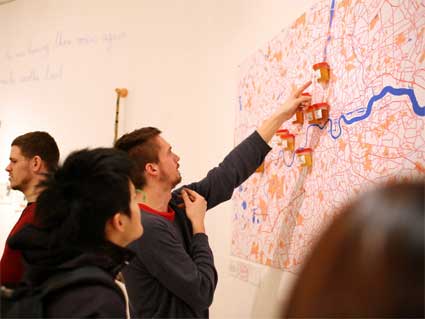
My City = My Body is part of ongoing research into future biological interactions with the city and more precisely into how the increasing understanding of our DNA and the rise of bio-technologies will change the way we interact with each other and our environment.
The first chapter of this exploration of new biological interactions is dedicated to Thames Water, London’s largest ‘drinking water and wastewater service company’. Making use of the work-in-progress-show at RCA, he offered tap water (kindly provided by Thames Water) and asked visitors to donate a urine sample along with their postcode. He added the samples and postcodes to a map of London which contains biological information.
Because i liked his project a lot and wanted to make sure i wouldn’t write anything too silly about it, i asked Tuur to give us more details about his research. I’m passing the microphone to him:
The installation / intervention in the show is part of a bigger, ongoing project called My City = My Body. I’m interested in how cities are not as much made up by streets and buildings as they are made up by our behaviour and experiences. (The London of a design-student, cycling around from Shoreditch to South-Ken is totally different from the London of a banker in a black cab with his blackberry and a loft in Notting Hill) These experiences are heavily mediated by technology, just look at the way mobile communication networks totally reshaped our cities.
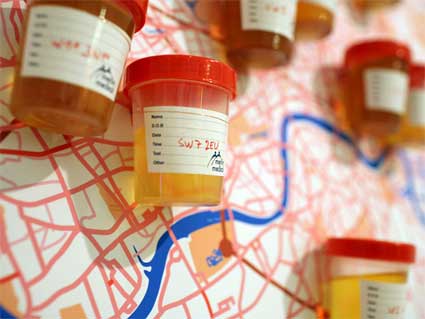
What I’m interested in, is how future technologies might influence our urban behaviour. We’re on the verge of a new area, an area that relies on the understanding of our body and the understanding of our DNA. What does this mean for the cities of tomorrow? Will we have DNA-surveillance and discrimination? Bio-identities and communities? …
The biological map in the interim show was an ‘intervention’ using the show as a platform to get feedback on these ideas. By gathering urine samples, I want to make people think about how their biological waste contains information. Pissing in public might become like leaving your digital data up for grabs, spitting in the streets like leaving your computer unprotected on the internet.
Unfortunately, I was not allowed to test the urine samples in the show. As England is the Mecca of Health&Safety, it was a struggle which took me up to Senior Management to even exhibit my project in this form (“Bio-hazard, sir!”) Continuing this research, I’m trying to contact a laboratory to look at bacteria, how bacteria could be a possible way of transforming our biological waste into information (inspired by Drew Endy‘s BioBricks project) and what the consequences in our everyday lives could be…
Thanks Tuur!
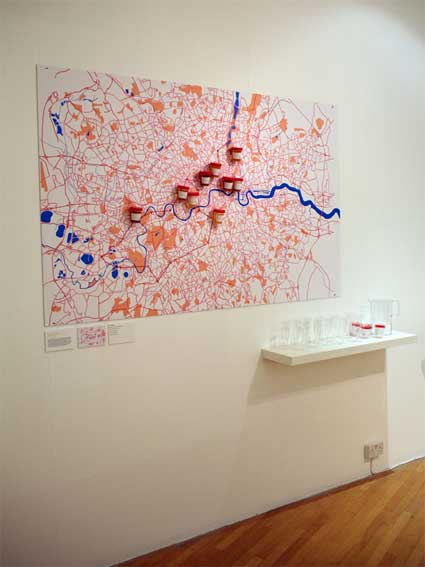
Images of the project courtesy of Tuur van Balen.
Previously: 24c3: The history of guerilla knitting. There’s more links and images about the congress on MAKE.
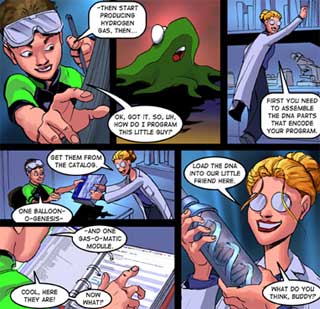 I agree with Eliot Phillips from Hack a Day: Drew Endy‘s talk on Programming DNA at 24c3 was the best thing i’ve listened to last week. The video is there for you to agree or disagree with us.
I agree with Eliot Phillips from Hack a Day: Drew Endy‘s talk on Programming DNA at 24c3 was the best thing i’ve listened to last week. The video is there for you to agree or disagree with us.
Endy, co-founder of the BioBricks Foundation (BBF), came to Berlin with the hope that “the conferees of 24C3 will help me to understand how to best enable an overwhelmingly constructive hacker culture for programming DNA”. Endy campaigns for a more open culture of biological technology, where biological engineering would not have to be confined to the laboratories of high-end industry laboratories.
Using BioBrickâ„¢ standard biological parts, a synthetic biologist or biological engineer can already, to some extent, program living organisms in the same way a computer scientist can program a computer. The DNA sequence information and other characteristics of BioBrickâ„¢ standard biological parts are made available to the public free of charge currently via MIT’s Registry of Standard Biological Parts.
Another video features Drew Endy discussing BioBrick standard biological parts and in this podcast he talks about open source biology.
Oh! And don’t miss the comic he worked on together with Isadora Deese & The MIT Synthetic Biology Working Group: Adventures in Synthetic Biology.